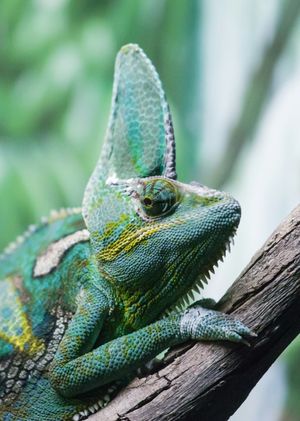
COMMON NAME: Veiled Chameleon
SCIENTIFIC NAME: Chamaeleo calyptratus
Veiled chameleons originate from the sandy deserts and dry grasslands of Yemen, Aden, and southwestern Saudi Arabia. These solitary, slow-moving lizards prefer to live alone and capture insect prey using their very long tongues. They can change colors from bright green to nearly black based on their mood and temperature. Adult males can be distinguished from females by their large casques or crests on their heads. As juveniles, the best way to tell the sex is to look for small "spurs" located at the back end of the hind feet, which are only found on males.
We recommend these tree-dwelling lizards have tall oriented screen enclosures since chameleons need good ventilation. Glass aquariums also typically don't provide enough ventilation for this species. The minimum sized enclosure for an adult should be 18 inches by 18 inches by 3 feet, but larger is better. Veiled chameleons are best housed alone due to aggression and territoriality.
Provide vines or branches for climbing. Live plants such as Ficus benjamina, golden pothos, or umbrella trees are good options. Ficus benjamina are excellent for climbing but can produce irritating sap when they are pruned, so remove them from the cage for pruning until the sap has dried.
Heating should be provided with an appropriately sized heat lamp. Cage temperature should be 85-90 on the warm side and no lower than 75 on the cool side. A basking spot of 95-100 should be provided near the top of the cage. Be sure that climbing branches do not get too close to the bulb, or the chameleon may burn its casque or back. Monitor temperatures using a digital thermometer with a probe or an infrared laser thermometer. We also recommend using a reptile thermostat to allow for better, more accurate, and safer control of cage temperatures.
UVB lighting is necessary for chameleons to properly absorb calcium from their diets in order to utilize it for hardening their bones. Reptiles living outdoors get their UVB directly from the sun. UVB cannot pass through normal glass, so placing an indoor reptile near a window will not supply them with the UVB they need. Reptiles housed indoors need to be provided artificial UVB light by the use of special bulbs specifically designed for reptiles.
If you're using a fluorescent UVB bulb, make sure your reptile can get within 12-18" of the bulb. Use branches or logs if needed so they can climb closer. Conversely, mercury vapor bulbs produce a large amount of heat, place these bulbs a minimum of 12" away from your reptile's basking spot. Dense screening material can block as much as 50% of the UVB lighting. If your cage has a very dense screen, multiple bulbs may be recommended.
UVB reptile bulbs should be replaced every 6-12 months depending the model, even if they are still producing visible light. UVB bulbs have a coating inside the glass that allows them to emit UVB lighting. This coating wears off after about 6-12 months and the bulb will stop producing the UVB your reptile needs.
Veiled chameleons are mostly insectivores, meaning the bulk of their diet is insects. However, this species is known to nibble on foliage (such as the golden pothos) from time to time. These lizards should be fed a variety of feeder insects daily. Select a variety of the following: crickets, mealworms, superworms, soldierfly larvae, waxworms, horn worms, silkworms, and dubia roaches. Feeder insects should be smaller than the width between your chameleon's eyes in order to be swallowed easily.
Captive reptile diets are notorious for being imbalanced in many vitamins and minerals. It is extremely common for their diets to have too high phosphorus and not have enough calcium. This can lead to calcium deficiencies and serious condition called nutritional secondary hyperparathyroidism (a.k.a. metabolic bone disease). We recommend chameleons' food be sprinkled with a calcium carbonate daily, such as Zoo Med's ReptiCal (without D3). We also recommend using a multivitamin 1-2 times a week. We recommend Zoo Med's Reptivite because vitamin A deficiencies are fairly common in many reptile species and Reptivite is one of the few reptile multivitamins which contain true vitamin A.
Their ideal humidity is between 40-60%. In dry climates or air-conditioned homes it is difficult to achieve proper humidity and droplet-drinking needs with hand-mist chameleons' enclosures. An automatic misting system set to go off intermittently throughout the day tends to provide better humidity control. Make sure to monitor humidity closely and adjust your mister's settings as necessary. Aim the misting system so that it causes droplets to form on perches, live plants, or artificial plants so your chameleon can drink from these droplets.
Copyright © All Rights Reserved
